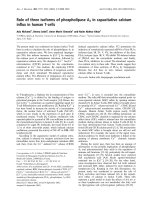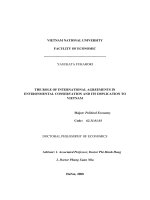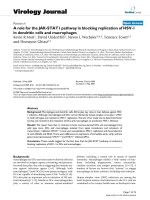Role of phospholipase a2 in orofacial pain and synaptic transmission 3
Bạn đang xem bản rút gọn của tài liệu. Xem và tải ngay bản đầy đủ của tài liệu tại đây (3.41 MB, 20 trang )
Chapter 4
Role of Group IIA sPLA
2
in nociception
121
4.3.4. Electron microscopy
The electron microscopy showed sPLA
2
-IIA immunoreactivity in neuronal
cell bodies and dendrites in the spinal cord. Label was observed on the
endoplasmic reticulum of neuronal cell bodies (Fig. 2.4.5A), and dendrites or
dendritic spines that were postsynaptic to unlabeled axon terminals (Fig. 2.4.5B
and C). The latter contained small round vesicles, typical of glutamatergic axon
terminals (Edwards, 1995).
Chapter 4
Role of Group IIA sPLA
2
in nociception
122
Fig. 2.4.5. Electron micrographs of sPLA
2
-IIA immunolabeled sections from the dorsal horn of the
spinal cord of a normal rat. (A) Section from the lumbar spinal segment. Reaction product (arrows)
is associated with the endoplasmic reticulum (ER) of a neuronal cell body. (B and C) Sections
from a cervical (B) or lumbar (C) spinal segment. Label is present in dendrites (D) that formed
asymmetrical synapses (S) with unlabeled axon terminals containing small round vesicles (AT).
Scale: A = 0.5 μm, B and C = 0.2 μm.
AT
S
D
B
A
ER
AT
S
D
C
Chapter 4
Role of Group IIA sPLA
2
in nociception
123
4.4. Discussion
The present study elucidated the expression profile of multiple sPLA
2
isoforms in the rat CNS with focus on sPLA
2
-IIA in the brainstem and spinal cord.
Expression of the sPLA
2
isoforms sPLA
2
-IB, sPLA
2
-IIA, sPLA
2
-IIC, sPLA
2
-X (with
secretory signals) and sPLA
2
-V (without secretory signal) were analysed in
various regions of the rat brain including the olfactory bulb, cerebral neocortex,
hippocampus, striatum, thalamus/ hypothalamus, cerebellum, brainstem and
cervical, thoracic and lumbar spinal segments using real-time RT-PCR. sPLA
2
-IB
expression was low throughout the CNS, sPLA
2
-IIA expression was high in the
brainstem and spinal cord, sPLA
2
-IIC expression was high in the cerebral
neocortex, hippocampus and thalamus/ hypothalamus, sPLA
2
-V expression was
high in the olfactory bulb and cerebellum, and sPLA
2
-X was expressed at very
low levels in the normal CNS. Of the isoforms, sPLA
2
-IIA mRNA expression was
highest in the brainstem and spinal cord suggesting that this could be the most
relevant isoform in the ascending pain pathway. Western blots showed bands at
14 kDa of sPLA
2
-IIA in homogenates from brainstem and spinal cord and a
second band at approximately 30 kDa in the spinal cord. The second band could
be due to dimerization of sPLA
2
-IIA. The expression of sPLA
2
-IIA in the spinal
trigeminal nucleus and dorsal horn cervical spinal segments was further analysed
by immunohistochemistry, and shown to be localized to neuronal cell bodies and
dendrites. The findings were consistent with previous results showing sPLA
2
-IIA
protein and activity in spinal cord homogenates of normal rats (Svensson et al.
2005). In contrast to the spinal cord, sPLA
2
-IIA mRNA level was not detected by
Chapter 4
Role of Group IIA sPLA
2
in nociception
124
ribonuclease protection assay in non-treated dorsal root ganglion neurons
(Morioka et al. 2002).
sPLA
2
-IIA is able to induce Ca
2+
influx via L-type voltage sensitive Ca
2+
channels (L-VSCCs) in rat cortical neuronal cells (Yagami et al. 2003b). External
application of sPLA
2
-IIA caused an increase in exocytosis and neurotransmitter
release from PC-12 cells as well as in the hippocampal neurons. This action of
sPLA
2
-IIA was completely abolished when the cells were treated with EGTA to
deplete Ca
2+
(Wei et al. 2003). sPLA
2
binds to presynaptic membrane after it is
released to enter the lumen of the synaptic vesicle and hydrolyze phospholipids
of the inner leaflet of synaptic vesicles. This process alters the phospholipid
composition of vesicles, and has been proposed to be critical for presynaptic
neurotransmission (Moskowitz et al. 1986; Kim et al. 1995b; Matsuzawa et al.
1996). sPLA
2
-IIA could itself be released by rat brain synaptosomes upon
stimulation by acetylcholine and glutamate receptors or via voltage dependent
Ca
2+
channels through depolarization (Kim et al. 1995b; Matsuzawa et al. 1996).
In view of its postsynaptic localization and the fact that sPLA
2
-IIA is a secreted
protein with a 21 amino acid signal peptide (Komada et al. 1990), it could be
postulated that sPLA
2
-IIA might be released from dendrites upon depolarization,
resulting in axonal exocytosis. This, postulated role of sPLA
2
-IIA as a secreted
neuromodulator during synaptic transmission seems consistent with previous
findings that sPLA
2
plays role in membrane depolarization and Ca
2+
entry which
is necessary for maintenance of healthy neurons: cerebellar granule neurons
require membrane depolarization and neurotrophic factors to survive in vitro, and
Chapter 4
Role of Group IIA sPLA
2
in nociception
125
sPLA
2
was shown to protect these neurons from apoptosis caused by K
+
deprivation. Moreover, the ability of sPLA
2
to promote neuronal survival is
inhibited when extracellular Ca
2+
is depleted or when L-type Ca
2+
channel is
blocked by nicardipine (Arioka et al. 2005).
The contribution of sPLA
2
in inflammation has been extensively studied.
Recent findings showed that sPLA
2
induced expression of pro-inflammatory
cytokines including TNF-α and IL-1β in the injured spinal cord (Liu et al. 2006).
sPLA
2
also provoked AA release and COX-2 expression in cultured neurons
independent of other cytokines (Kolko et al. 2003). Conversely, there is strong
evidence to support that sPLA
2
-IIA in vitro and in vivo can be upregulated by
cytokines and also by TNF-α and IL-1α/β after transient focal cerebral ischemia
in rats (Adibhatla and Hatcher 2007). This induction of sPLA
2
-IIA expression is
suppressed by anti-inflammatory glucocorticoids and downregulated by
transforming growth factor and platelet-derived growth factor (Murakami et al.,
1997; Kudo and Murakami, 2002). Moreover, astrocytes isolated from mice
deficient of sPLA
2
-IIA gene were less sensitive to cytokines to produce PGE
2
than those astrocytes which expressed sPLA
2
-IIA (Xu et al. 2003a). In addition,
IL-1β and TNFα activate COX-2 to maintain the pro-inflammatory pathways
(Kuwata et al. 1998; Murakami et al. 1999; Sawada et al. 1999; Morioka et al.
2000a; Morioka et al. 2002), affirming the role of sPLA
2
in inflammation.
The present finding of dense immunolabeling of sPLA
2
-IIA in the spinal
trigeminal nucleus of the brainstem and dorsal horn of the cervical spinal cord is
consistent with previous findings of an important role of sPLA
2
in nociceptive
Chapter 4
Role of Group IIA sPLA
2
in nociception
126
transmission, both from the orofacial region (Yeo et al. 2004) and the rest of the
body. IT injection of sPLA
2
inhibitor, LY311727 significantly reduced nociception
after inflammation-induced hyperalgesia. sPLA
2
inhibition results in attenuation of
hypersensitivity, even after direct activation of second order dorsal horn neurons
(Svensson et al. 2005). In conclusion, the above findings in this study support an
important role of sPLA
2
-IIA in nociceptive transmission in the brainstem and
spinal cord. The mechanism by which sPLA
2
-IIA is secreted could be via kainate-
receptor binding. sPLA
2
-IIA is released upon stimulation by kainate and this
effect is abolished by addition of UBP 302, a GluR5 specific kainate receptor
antagonist (Than et al. 2011). This evidence suggests that sPLA
2
-III could be
released via the similar mechanism as this enzyme is also localized in the
dendrites. The evidence of sPLA
2
-IIA localization and release supported that it
plays an active role in the synaptic transmission. Moreover, it has been shown
that after external application of sPLA
2
-IIA to cultured hippocampal neurons and
PC-12 cells, it resulted in an instantaneous increase in exocytosis (Wei et al.
2003).
Chapter 5
Role of lysophospholipids in synaptic transmission
127
CHAPTER 5
ROLE OF LYSOPHOSPHOLIPIDS IN SYNAPTIC TRANSMISSION
Chapter 5
Role of lysophospholipids in synaptic transmission
128
5.1. Introduction
Exocytosis is the release of neurotransmitters from synaptic vesicles via
targeting and fusion events which are similar to the release of secretory proteins.
In resting neurons some synaptic vesicles filled with neurotransmitters are
‘‘docked’’ at the plasma membrane while others are in reserve near the plasma
membrane at the synaptic cleft. Synaptic vesicle membranes contain Ca
2+
-
binding proteins such as synaptotagmin that can detect cytosolic Ca
2+
increase
after the arrival of an action potential, to trigger rapid fusion of docked vesicles
with the synaptic membrane and release of neurotransmitters (Lodish H 2007).
PLA
2
differ in structure, enzymatic properties, subcellular localization and
cellular functions and include sPLA
2
, cPLA
2
and iPLA
2
isoforms (Farooqui et al.
2006). sPLA
2
has been shown to be associated with synaptosomes and synaptic
vesicle fractions (Kim et al. 1995b; Matsuzawa et al. 1996). PLA
2
is able to
disrupt the synaptic vesicle integrity in a Ca
2+
- dependent manner (O'Regan et al.
1995a; O'Regan et al. 1995b; O'Regan et al. 1996), and stimulation of PLA
2
in
synaptic vesicles correlates with induction of vesicle-vesicle aggregation and
alterations in vesicle permeability. sPLA
2
binds to the presynaptic membrane,
enters the lumen of the synaptic vesicle during the vesicle’s retrieval from the
plasma membrane, and hydrolyzes phospholipids of the inner leaflet of synaptic
vesicles (Matsuzawa et al. 1996; Wei et al. 2003). SPANs hydrolyze
phospholipids of cultured neurons with generation of a lysophospholipid, lysoPC
and fatty acids (Rigoni et al. 2005). This leads to massive release of synaptic
vesicles, with their incorporation into the presynaptic plasma membrane and
Chapter 5
Role of lysophospholipids in synaptic transmission
129
consequent surface exposure of synaptic vesicle luminal epitopes (Rigoni et al.
2005). LysoPC does not only facilitates synaptic vesicle fusion but it is also
involved in dopamine turnover. In endothelial cells, it is also involved in
modulating Ca
2+
signals and inhibits the phosphorylation of nitric oxide synthase
and cPLA
2
(Millanvoye-Van Brussel et al. 2004). LysoPC is not simply a lipid
metabolite producing neurotrophic and neurotoxic effects. It participates in signal
transduction processes. LysoPC activates protein kinases such as PKC, PKA,
and c-jun terminal kinase (Boggs et al. 1995; Gomez-Munoz et al. 1999). In
addition, bee venom (melittin) mediated stimulation of PLA
2
and generation of
LysoPI in pancreatic islet cells promotes the release of insulin in a dose-
dependent manner. This effect is reversible, saturable and has no effect on
subsequent islet cell functioning (Metz 1986).
Lysophospholipids are able to modify the function of membrane proteins
including ion channels. These alterations can take place through signal
transduction pathways, for instance by binding to lysophospholipid receptors
(Tachikawa et al. 2009) or via ‘‘direct’’ effects on the cell membrane (Lundbaek
and Andersen 1994). High concentrations of lysophospholipids may act as
detergents to disrupt membrane structures (Weltzien 1979; Farooqui and
Horrocks 2007), thus affecting the function of membrane proteins such as K
+
channels (Kiyosue and Arita 1986), voltage-dependent Na
+
channels (Burnashev
et al. 1989) and K(ATP) channels. The properties of lysophospholipids suggest
that they may be active participants in sPLA
2
-mediated exocytosis (Amatore et al.
2006). Different levels of sPLA
2
activity are present in various parts of the CNS
Chapter 5
Role of lysophospholipids in synaptic transmission
130
(Thwin et al. 2003) and the sPLA
2
-IIA isoform has been shown to induce
exocytosis in cultured hippocampal neurons (Wei et al. 2003). However, until
now, little is known about possible contributions of various lysophospholipid
species to exocytosis in neurons or endocrine cells. This study was therefore
carried out using total internal reflection microscopy (TIRFM), capacitance
measurements and amperometry, to examine the effects of several
lysophospholipid species, lysoPC, lysoPS and lysoPI on exocytosis in a
neuroendocrine cell, the rat PC-12 cells.
Chapter 5
Role of lysophospholipids in synaptic transmission
131
5.2. Materials and methods
5.2.1. TIRFM
The effect of external infusion of lysoPC, lysoPS (Avanti, Alabaster,
Alabama) and lysoPI (from Sigma-Aldrich, St Louis, MI, USA) (200 nM, diluted
from 200 μM stock in ethanol vehicle) on vesicle fusion in PC-12 cells was
studied by TIRFM as previously described (Allersma et al. 2004; Tang et al. 2007;
Zhang et al. 2009). LysoPC, lysoPS and lysoPI were selected for study since
they were readily soluble in a relatively non-toxic solvent, ethanol. In contrast,
lysoPE and lysoPA were much less soluble in ethanol or aqueous buffers, and
were not further analyzed. In brief, PC-12 cells were cultured in RPMI
supplemented with 10% horse serum, 5% fetal bovine serum (both from Gibco,
Invitrogen, Carlsbad, CA, USA) and 1% penicillin/streptomycin at 37
o
C and 5%
CO
2
. Neuropeptide Y (NPY)-enhanced green fluorescence protein (EGFP)
plasmid was a kind gift from Dr Wolf Almers (Vollum Institute, Oregon Health
Sciences University). Cells were plated onto poly-L-lysine coated glass
coverslips and transfected with 2 μg of NPYEGFP plasmid using FuGENE
Transfection Reagent (FuGENE, Roche, USA), 1–2 days before the imaging
experiments. The cells were then transferred to buffer solution containing (in mM):
150 NaCl, 5.4 KCl, 2 MgCl
2
, 1.8 CaCl
2
and 10 HEPES (pH 7.4) for TIRFM. The
measurements were carried out using a Zeiss Axiovert 200 inverted microscope.
EGFP was excited by 488 nm laser and the emission light was collected at 520
nm. Time-lapse digital images were acquired at 1 or 0.2 Hz by a CCD camera
with exposure time of 18 ms, and image stacks were analyzed using MetaMorph
Chapter 5
Role of lysophospholipids in synaptic transmission
132
6.3 software (Universal Imaging, Downingtown, PA, USA). The number of
subplasmalemmal vesicles was counted, and the means of 11–24 cells in each
treatment calculated.
5.2.2. Capacitance measurements
The effects of lysoPC, lysoPS and lysoPI on vesicle fusion during
exocytosis were also quantified using capacitance measurement as previously
described (Gillis 1995; Chen and Gillis 2000; Chen et al. 2001; Sun and Wu 2001;
Zhang and Zhou 2002; Wei et al. 2003). PC-12 cells were cultured in RPMI
Medium supplemented with 10% fetal bovine serum and 1%
penicillin/streptomycin (Gibco, Invitrogen). The cells were plated in 35 mm Petri
dishes, and maintained in an incubator at 37
o
C, 100% humidity, with 95% air
and 5% CO
2
. Coverslips containing attached cells were transferred to a fresh 35
mm dish containing 2 ml of external solution prior to the patch-clamp experiments.
Capacitance measurements were carried out on PC-12 cells under whole cell
voltage clamp conditions, using 3–7 MOhm pipettes. The series resistance
ranged from 8 to 16 MOhms. Measurements were performed using an EPC-9
patch-clamp amplifier (HEKA Electronics, Germany) and the Lindau-Neher
(‘‘sine+dc’’) technique (Gillis 1995) implemented in Pulse software. Only cells that
were stably voltage-clamped were analyzed. These showed fairly stable series
resistance throughout the recording (10–12 MOhm) with no sudden changes of
more than 10%. Capacitance values were recorded from each cell during the first
30 s after addition of lysoPC, lysoPS or lysoPI and divided by the value
Chapter 5
Role of lysophospholipids in synaptic transmission
133
immediately before addition of lysophospholipids, to yield a normalized value.
This was to take into account slight differences in initial capacitance between
cells of different sizes. A total of 10–12 cells were recorded in each group.
Possible significant differences were analyzed by Student’s t test. P < 0.05 was
considered significant. Experimental studies were also carried out by to explore
possible factors that could affect exocytosis induced by lysoPI: (1) Cells were
pre-treated with MBCD which disrupts the integrity of cholesterol rich domains or
‘‘lipid rafts’’ on the cell membrane (Ko et al. 2005; Sun et al. 2005; Shvartsman et
al. 2006) to determine a possible role of cholesterol rich domains on the cell
membrane in the effects of lysoPI. PC-12 cells were incubated with 10 mM
MBCD (Sigma-Aldrich) for 10 min at 37
o
C, and washed twice with PBS before
transfer to external solution and addition of lysoPI. (2) Cells were pretreated with
thapsigargin to deplete [Ca
2+
]i stores, and recorded in zero Ca
2+
conditions, to
determine a possible role of [Ca
2+
]i in the effects of lysoPI. PC-12 cells were
incubated with 1 μM thapsigargin for 15 min at room temperature and transferred
to external solution containing EGTA (Sigma-Aldrich) dissolved in (mM) 150 NaCl,
2.8 KCl, 10 EDTA, 1 MgCl
2
and 10 HEPES and 2 mg/ml glucose pH 7.2 (310
mOsm), before infusion of lysoPI.
5.2.3. Amperometry measurements
The quantal release of catecholamines from PC-12 cells after external
application of lysoPI was also analyzed using carbon fiber electrodes as
previously described (Chow et al. 1992; Bruns et al. 2000). Amperometric
Chapter 5
Role of lysophospholipids in synaptic transmission
134
currents were recorded using highly sensitive low-noise carbon fiber electrodes
(ALA Scientific Instruments) with an EPC-9 amplifier (HEKA Elektronik, Germany)
with electrode voltage set to 780 mV. The tip of the electrode was cut with a
surgical blade before recordings, to ensure cleanliness and sensitivity of its
surface. The recordings were filtered at 1 kHz, digitized at 10 kHz, and analyzed
using custom software. Each treatment group consists of ten to twelve cells.
Possible significant differences between the groups were analyzed using two-
tailed unpaired Student’s t-test. P < 0.05 was considered significant.
5.2.4. Intracellular calcium imaging
[Ca
2+
]i concentration of PC-12 cells was analyzed after external infusion of
lysoPI as previously described (Pal et al. 1999; Raza et al. 2001). PC-12 cells
were cultured on glass bottom culture dishes, and loaded with acetoxymethyl
form of the membrane-permeable ratiometric fluorescent Ca
2+
indicator Fura-2 (5
µM, Invitrogen) in HEPES buffer for 1 h at 37 °C. Loaded cells were washed two
times with buffer and incubated for an additional 30 min to allow for cellular
esterase cleavage of the acetoxymethyl moiety and intracellular trapping of the
free acid Fura-2 indicator. Alternating excitation wavelengths of 340 and 380 nm
were generated using an OptoScan Monochromator (Cairn Research Limited)
and 510-nm emissions acquired through a Fura filter cube with a dichroic at 400
nm (Omega Optical Inc. XF-04-2, Brattleboro, USA), and a CoolSNAP HQ2
digital CCD camera (Photometrics, Tucson, AZ). Images were acquired and
processing using MetaMorph 7.0.4 software (Molecular Devices, Sunnyvale, CA,
Chapter 5
Role of lysophospholipids in synaptic transmission
135
USA). Background autofluorescence values for both 340- and 380-nm excitations
were obtained and subtracted from experimental 340/380-nm excitation-emission
values. Regions of interest corresponding to PC-12 cells were selected, and the
ratio of 340/380-nm excitation-emissions in these regions calculated to give an
indication of [Ca
2+
]i levels. Each treatment group measured 10-12 cells.
Chapter 5
Role of lysophospholipids in synaptic transmission
136
5.3. Results
5.3.1. TIRFM (Fig. 2.5.1.)
A pronounced increase in the rate of membrane fusion indicating
exocytosis was observed after external infusion of lysoPI (Fig. 2.5.1.). The
vesicles were depleted by 58.3 ± 5.6% after lysoPI treatment for 2 min. In
comparison, vesicles were depleted by 48.3 ± 10.7%, 25.5 ± 6.6% and 25.2 ±
11.0% after lysoPC, lysoPS or ethanol treatment for 2 min, respectively (Fig.
2.5.1C).
LysoPC, lysoPS and ethanol (vehicle control) were also less effective or
ineffective in inducing vesicle fusion, compared to lysoPI (Fig. 2.5.1D). LysoPI
increased vesicle delivery to the subplasmalemmal membrane (53.86 ± 4.40
vesicles per 2 min), while lysoPC and lysoPS had no effect compared to vehicle
treated controls (lysoPC, 18.63 ± 5.17 vesicles; lysoPS, 13 ± 1.73 vesicles;
ethanol, 8.17 ± 1.80 vesicles).
Chapter 5
Role of lysophospholipids in synaptic transmission
137
Fig.2.5.1. TIRFM imaging of vesicles footprints and fusion events happened at subplasmalemmal
region. A: An example recording of secretory vesicles reduction before (left) and ~2 min after
(right) lysoPI stimulation. Predocking vesicles were labeled with circles, which represented
vesicles appearing on the first plane of a stack; new-delivered vesicles were labeled with squares.
B: Representative process of a fusion event captured at 2 Hz.
Chapter 5
Role of lysophospholipids in synaptic transmission
138
Fig.2.5.1. TIRFM imaging of vesicles footprints and fusion events happened at subplasmalemmal
region. C: Lysophospholipids triggered exocytosis in PC-12 cells. LysoPI was most effective in
depleting vesicles while the lysoPC and lysoPS which have less significant vesicle reduction ratio
as compared to vehicle control ethanol. D: LysoPI increased vesicles delivery to the
subplasmalemmal membrane while lysoPC and lysoPS had no significant effect in new vesicle
delivering compared to vehicle control. *: significant difference compared to ethanol (vehicle
control) (P < 0.05 analyzed by Student’s t-test).
5.3.2. Capacitance measurements (Fig. 2.5.2., 2.5.3.)
There was significant increase in membrane capacitance by 1.04 ± 0.02%
compared to the resting state, after addition of lysoPI for 30 s. This indicates
significant induction of exocytosis after addition of lysoPI. In contrast, no
significant change in capacitance was observed after addition of lysoPC (0.97 ±
0.02%), lysoPS (1.01 ± 0.01%) or ethanol (vehicle control) (1.01 ± 0.01%) (Fig.
2.5.2.). Pre-incubation of cells with MBCD, resulted in attenuation of lysoPI
C
D
Lyso
PI
Lyso
PC
Lyso
PS
Ethanol
LysoPI
Lyso
PC
Lyso
PS
Ethanol
Chapter 5
Role of lysophospholipids in synaptic transmission
139
induced exocytosis (1.01 ± 0.01%) (Fig. 2.5.3.). Cells that were pre-treated with
thapsigargin and recorded in zero Ca
2+
conditions also showed no induction of
exocytosis after addition of lysoPI (0.99 ± 0.01%) (Fig. 2.5.3.).
Chapter 5
Role of lysophospholipids in synaptic transmission
140
Fig.2.5.2. Capacitance measurements. There was a significant increase in membrane
capacitance indicating exocytosis after addition of lysoPI. In contrast, no significant change in
capacitance was observed after addition of lysoPC and lysoPS. *: significant difference compared
to ethanol (vehicle control) (P < 0.05 analyzed by Student’s t-test).
0.96
1.00
1.04
1.08
5 30
Time(s)
Normalized
Capacitance(%)
Ethanol
LysoPI
*
B
0.96
1.00
1.04
1.08
5 30
Time(s)
Normalized
Capacitance(%)
Ethanol
LysoPC
A
0.96
1.00
1.04
1.08
5 30
Time(s)
Normalized
Capacitance(%)
Ethanol
LysoPS
C









